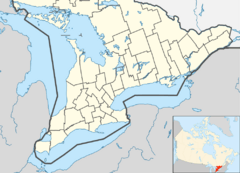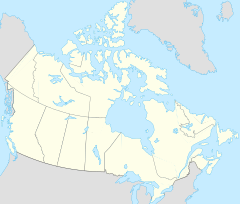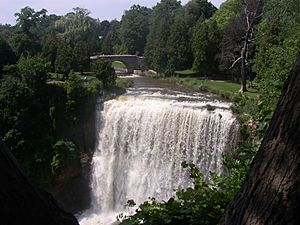Hamilton, Ontario facts for kids
Quick facts for kids
Hamilton
|
|||||
|---|---|---|---|---|---|
| City of Hamilton | |||||
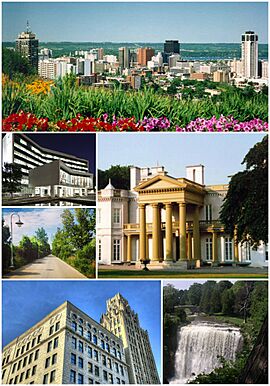
From top, left to right: Downtown Hamilton from Sam Lawrence Park, Hamilton City Hall, Bayfront Park Harbour Front Trail, Dundurn Castle, Historic Art Deco and Gothic Revival Pigott Building complex, Webster's Falls
|
|||||
|
|||||
| Nicknames:
"The Ambitious City", "The Electric City", "The Hammer", "Steeltown"
|
|||||
| Motto(s):
English: Together Aspire – Together Achieve
|
|||||
| Country | Canada | ||||
| Province | Ontario | ||||
| Region | Southern Ontario | ||||
| Incorporated | June 9, 1846 | ||||
| Named for | George Hamilton | ||||
| Government | |||||
| • Type | Single-tier municipality with a mayor–council system | ||||
| • Body | Hamilton City Council | ||||
| Area | |||||
| • City (single-tier) | 1,118.31 km2 (431.78 sq mi) | ||||
| • Urban | 356.03 km2 (137.46 sq mi) | ||||
| • Metro | 1,373.15 km2 (530.18 sq mi) | ||||
| Population
(2021)
|
|||||
| • City (single-tier) | 569,353 (10th) | ||||
| • Density | 509.1/km2 (1,319/sq mi) | ||||
| • Urban | 729,560 | ||||
| • Metro | 785,184 (9th) | ||||
| Demonym(s) | Hamiltonian | ||||
| GDP | |||||
| • Hamilton CMA | CA$37.0 billion (2020) | ||||
| Time zone | UTC−05:00 (EST) | ||||
| • Summer (DST) | UTC−04:00 (EDT) | ||||
| Area codes | 905, 289, 365, and 742 | ||||
Hamilton is a port city in the Canadian province of Ontario. It is located southwest of Toronto on the western end of Lake Ontario. In 2021, Hamilton had a population of over 569,000 people. If you include nearby areas like Burlington and Grimsby, the population grows to over 785,000.
The city was started by George Hamilton after the War of 1812. It quickly became a busy industrial area at the west end of Lake Ontario, known as the Golden Horseshoe. In 2001, Hamilton joined with several nearby towns to form the city we know today. People who live here are called Hamiltonians.
For a long time, Hamilton was famous for its steel and heavy manufacturing industries. But in recent years, it has changed to focus more on services, especially health and science. Hamilton is also home to many cool places like the Royal Botanical Gardens, the Canadian Warplane Heritage Museum, and McMaster University. McMaster University is one of the top universities in Canada and the world.
Contents
History of Hamilton
Early Days and Founding
Long ago, the land where Hamilton now stands was used by the Neutral First Nation. Later, the Five (or Six) Nations took over the area. In 1792, the British Crown bought this land from the Mississaugas people.
After the American Revolutionary War, many people loyal to the British, called United Empire Loyalists, moved from the United States to southern Ontario. They were given land in this area. More Americans followed, looking for affordable farmland. Also, many Iroquois who had helped the British moved here.
During the War of 1812, British soldiers and local Canadian fighters won a battle against American troops at the Battle of Stoney Creek. This battle happened in what is now eastern Hamilton.
The city of Hamilton began when George Hamilton bought a farm in 1815. He worked with another landowner, Nathaniel Hughson, to suggest building a courthouse and jail on Hamilton's land. This helped make Hamilton the main administrative center for the new Gore District in 1816.
Growth and Development
Hamilton really started to grow in 1832 when a canal was built. This canal connected the city to Lake Ontario, making Hamilton a major port. The city officially became a city on June 9, 1846.
By 1845, Hamilton had a population of almost 6,500 people. It had good roads, stagecoaches, and steamboats connecting it to other towns. There were many businesses, including banks, breweries, and stores.
In the late 1800s, Hamilton built many important buildings. It also had Canada's first commercial telephone service and the British Empire's first telephone exchange. The city used electric street railways and inclines, showing it was a leader in technology.
Modern Era and Changes
Hamilton's population grew a lot between 1900 and 1914. Big steel companies like Stelco and Dofasco started here. Other large companies, like Procter & Gamble, also opened plants. Even during World War I, the city's industries were booming.
Growth continued until the 1960s. The city's first skyscraper, the Pigott Building, was built in 1929. McMaster University moved to Hamilton in 1930. The first Tim Hortons store opened here in 1964.
However, many large industries later moved or closed down. In 2001, the "old" City of Hamilton joined with five nearby towns: Ancaster, Dundas, Flamborough, Glanbrook, and Stoney Creek. This created the new, larger city of Hamilton, which had over 519,000 people at the time.
In 2013, the Stelco steel mills closed permanently. This showed a big change in Hamilton's economy, as fewer people worked in manufacturing.
Geography and Nature
Location and Key Features
Hamilton is located in Southern Ontario, right on the western edge of Lake Ontario. Most of the city, including its downtown, is on the south shore of the lake. Hamilton is in the middle of the Golden Horseshoe region.
The city has two main natural features:
- Hamilton Harbour: This is a natural harbor that forms the northern edge of the city.
- Niagara Escarpment: This is a large ridge of land that runs through the middle of the city. It divides Hamilton into an "upper" part and a "lower" part. The highest point in the city is about 250 meters (820 feet) above Lake Ontario.
Long ago, the native Neutral people called this area Attiwandaronia. Hamilton is known for balancing its industrial side with its beautiful natural areas.
Hamilton's Waterfalls and Green Spaces
Hamilton is famous for its many waterfalls! There are over 100 waterfalls and cascades, mostly found along the Niagara Escarpment. Many of these are near the Bruce Trail, a long hiking path that follows the escarpment.
The Hamilton Conservation Authority manages about 4,500 hectares (11,000 acres) of land, and the city has over 1,000 hectares (2,500 acres) of parkland. Many parks are along the Niagara Escarpment, offering amazing views of the cities below.
It's important to know that the water quality in some waterfalls can be poor because of runoff from streets and sewers. So, it's best to enjoy the views from a distance.
Climate and Weather

Hamilton has a humid continental climate. This means it has warm, humid summers and cold winters. The weather can change quickly. Even though it's cold in winter, Hamilton's climate is milder than most of Canada.
The highest temperature ever recorded in Hamilton was 41.1 °C (106 °F) on July 14, 1868. The coldest was −30.6 °C (−23 °F) on January 25, 1884.
Economy and Industry
Manufacturing is very important to Ontario's economy. The area around Toronto and Hamilton is the most industrialized part of Canada. This region, known as the Golden Horseshoe, had about 8.1 million people in 2006.
Hamilton is often called the Steel Capital of Canada. This is because companies like Stelco and Dofasco used to produce a large amount of Canada's steel here.
Dofasco, which is part of a larger steel company called ArcelorMittal, makes steel products for cars, buildings, and other industries. It has about 7,300 employees at its Hamilton plant and produces millions of tons of steel each year.
People and Culture
Population and Diversity
In 2021, Hamilton had a population of 569,353 people. The city is growing, and its population density is about 509 people per square kilometer.
Hamilton is a very diverse city. In 2016, about a quarter of the people living in Hamilton were born outside of Canada. The city has welcomed many immigrants over the years. In 2014, Hamilton became a "sanctuary city," meaning it offers city services to immigrants who might be at risk of deportation.
The city has many different ethnic backgrounds. Many Hamiltonians have Italian, English, Scottish, German, and Irish roots. There are also growing communities from South Asia, Africa, the Middle East, and Southeast Asia.
Hamilton also has a notable French-speaking community. French services are offered in the city, and there are French schools and cultural centers.
Religion in Hamilton

Christianity is the most common religion in Hamilton, with about 55% of the population identifying as Christian in 2021. Catholicism is the largest Christian group. The Christ the King Cathedral is an important Catholic church in the city.
Other religions are also growing in Hamilton due to immigration. These include Islam, Hinduism, and Sikhism. About 32% of the population reported having no religious affiliation in 2021.
Arts and Attractions
Hamilton has many fun attractions to visit:
- Canadian Warplane Heritage Museum: See old airplanes and learn about their history.
- HMCS Haida National Historic Site: Visit a real historic warship.
- Dundurn Castle: Explore a beautiful old mansion.
- Royal Botanical Gardens: Enjoy stunning gardens and natural areas.
- Canadian Football Hall of Fame: Learn about Canadian football legends.
- African Lion Safari: See exotic animals up close.
The Art Gallery of Hamilton, founded in 1914, is Ontario's third-largest public art gallery. It has over 9,000 artworks, including Canadian and European pieces. McMaster University also has its own art museum.
Supercrawl is a huge arts and music festival that happens every September on James Street North. It brings in hundreds of thousands of visitors. Hamilton also hosted the JUNO Awards, a big music awards show, in 2015.
The city's art scene has been growing, with many new art galleries opening. This has made Hamilton a popular spot for artists.
Sports and Recreation

Hamilton has a rich sports history. It hosted the first Commonwealth Games (then called the British Empire Games) in 1930. The city also co-hosted the 2015 Pan Am Games with Toronto, which helped build new sports facilities like a multi-purpose stadium and a swimming pool.
Hamilton's main sports teams include:
- Hamilton Tiger-Cats: This team plays in the Canadian Football League (CFL). Their home stadium is Tim Hortons Field. The team started way back in 1869!
- Forge FC: This is Hamilton's professional soccer team, playing in the Canadian Premier League. They also play at Tim Hortons Field and won the league championship in their first season (2019).
- Hamilton Honey Badgers: This was Hamilton's basketball team in the Canadian Elite Basketball League. They played at the FirstOntario Centre but moved to Brampton in 2022.
- Hamilton Cardinals: This baseball team plays in the Intercounty Baseball League at Bernie Arbour Memorial Stadium.
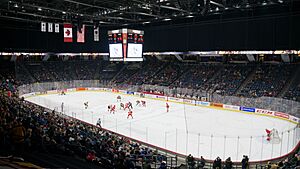
Hamilton is also home to the Canadian Football Hall of Fame museum. The city hosts the Around the Bay Road Race, which is the longest continuously held long-distance foot race in North America. For racing fans, there's Flamboro Speedway for auto races and Flamboro Downs for horse racing.
Education and Learning
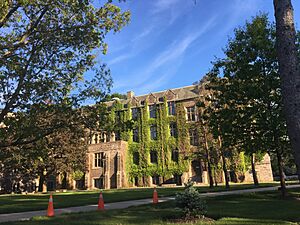
Hamilton has several great places for higher education:
- McMaster University: This large university moved to Hamilton in 1930. It has about 30,000 students, many of whom come from outside the Hamilton area.
- Mohawk College: This college offers many applied arts and technology programs. It has thousands of full-time and part-time students.
- Redeemer University: A private Christian university that opened in 1982.
For younger students, there are four main school boards:
- Hamilton-Wentworth District School Board (public schools)
- Hamilton-Wentworth Catholic District School Board (Catholic schools)
- Conseil scolaire Viamonde (French public schools)
- Conseil scolaire catholique MonAvenir (French Catholic schools)
There are also several independent Christian schools and Hillfield Strathallan College, a private school for students from kindergarten to grade twelve. Columbia International College is Canada's largest private boarding high school, with students from many different countries.
For arts education, the Dundas Valley School of Art and the Hamilton Conservatory for the Arts offer programs for young artists, dancers, and musicians.
Getting Around Hamilton
Transportation Options
Hamilton is well-connected by highways, including Highway 403, the QEW, the Lincoln M. Alexander Parkway, and the Red Hill Valley Parkway.
Public transportation within the city is provided by the Hamilton Street Railway, which runs a large bus system. Hamilton and Metrolinx are also planning to build a LRT (Light Rail Transit) line in the coming years.
For travel to other cities, GO Transit offers bus and train services, including frequent trips to Toronto. The Hamilton GO Centre is the main station for these services.
John C. Munro Hamilton International Airport
The John C. Munro Hamilton International Airport is an important hub for both passengers and cargo. It used to be a wartime air force training station. Today, it handles hundreds of thousands of passengers each year, with flights to destinations in Canada, the United States, Mexico, and Central America.
The airport is also a major cargo center, operating 24/7. Large courier companies like United Parcel Service and Cargojet Canada use this airport. The city is working on plans to develop a large industrial park around the airport, which could create many new jobs.
Port of Hamilton
Hamilton also plays a big role in shipping by water. The Port of Hamilton is Ontario's busiest port. It handles millions of tons of cargo every year, helping to move goods across the region.
Major Highways in Hamilton
Sister Cities
Hamilton has "sister city" relationships with ten cities around the world. These partnerships help promote cultural exchange and understanding.
 Shawinigan, Quebec, Canada (1958)
Shawinigan, Quebec, Canada (1958) Kaga, Ishikawa, Japan (1968)
Kaga, Ishikawa, Japan (1968) Mangalore, Karnataka, India (1968)
Mangalore, Karnataka, India (1968) Fukuyama, Hiroshima, Japan (1975)
Fukuyama, Hiroshima, Japan (1975) Racalmuto, Sicily, Italy (1987)
Racalmuto, Sicily, Italy (1987) Ma'Anshan, Anhui, China (1987)
Ma'Anshan, Anhui, China (1987) Flint, Michigan, United States (1987)
Flint, Michigan, United States (1987) Sarasota, Florida, United States (1991)
Sarasota, Florida, United States (1991) Valle Peligna, Abruzzo, Italy (1991)
Valle Peligna, Abruzzo, Italy (1991) Monterrey, Nuevo León, Mexico (1993)
Monterrey, Nuevo León, Mexico (1993)
See also
 In Spanish: Hamilton (Ontario) para niños
In Spanish: Hamilton (Ontario) para niños





